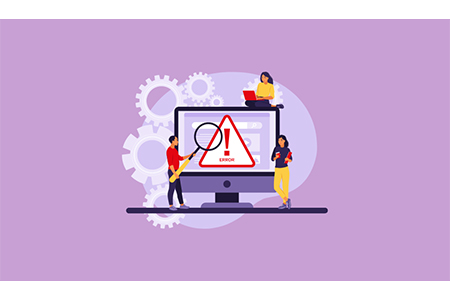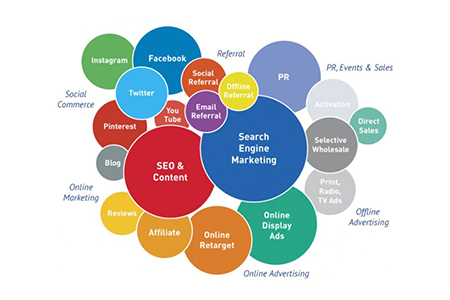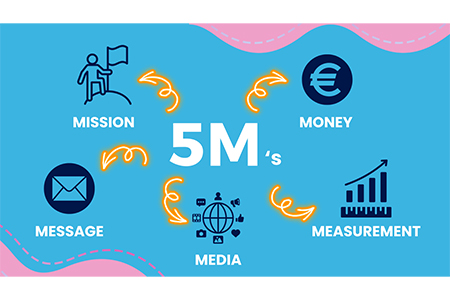
No matter how brilliant a product is, if people don’t hear about it, it won't grow. That’s where advertising steps in. But creating ads that actually work isn’t just about spending money or throwing catchy slogans out there. It takes strategy. That’s where the 5 M’s of advertising come into play — a simple but powerful framework to build campaigns that deliver results.The 5m model of advertising simplifies your approach, making it easier to design campaigns that are effective and measurable. Whether you’re new to marketing or refining your strategy, the 5m's of advertising offers a dependable structure. When brands start to understand and apply the five m's of advertising, they’re more likely to succeed in building awareness, driving sales, and creating lasting impressions.
Introduction – What Are the 5 M’s of Advertising?
The 5 M’s of advertising are Mission, Money, Message, Media, and Measurement. These five pillars help businesses create a well-rounded and result-driven advertising plan.
- Mission defines why you're advertising in the first place.
- Money sets the limits and potential of your campaign.
- Message is what you communicate to your audience.
- Media is where you place your message.
- Measurement tells you how well everything worked.
Together, they guide every step of an advertising campaign, from planning to execution and optimization. Whether you're a startup or a well-established brand, applying these five elements can help you run smarter and more effective advertising. The 5 m of advertising is not just a concept — it’s a tool for building strategy.
Mission – Defining the Purpose of Advertising

Before you write a single word of your ad or spend a dollar on media, you need to be clear about your mission. What are you trying to achieve with your advertising?
Understanding Advertising Goals
H4: Brand Awareness vs. Sales-Driven Ads
Some ads are meant to make people aware of your brand. Others are designed to drive sales directly. Awareness campaigns usually focus on exposure and storytelling. Sales-driven ads go straight to the point with offers, deals, and urgency.
H4: Customer Retention vs. New Customer Acquisition
Are you trying to keep your current customers engaged or reach new ones? Retention ads often rely on loyalty programs and personalized messaging. Acquisition ads need to appeal to people who have never heard of you before, often requiring more attention-grabbing content.
How to Set SMART Advertising Objectives
To keep things focused, use SMART objectives — Specific, Measurable, Achievable, Relevant, and Time-bound. Instead of saying “I want more sales,” a SMART goal would be “Increase online sales by 20% over the next three months through targeted ads on Facebook and Instagram.”
Money – Budgeting for Advertising Success

A well-thought-out budget doesn’t limit creativity — it sharpens it. Knowing how much you can spend and where that money will go helps make smarter decisions.
Factors That Influence Ad Budgeting
Business Size & Industry
Larger companies usually have bigger budgets, but that doesn’t mean small businesses can’t advertise effectively. Some industries also require more aggressive advertising due to intense competition.
H4: Target Audience & Market Competition
If you're targeting a broad or highly competitive market, you'll need a higher budget to cut through the noise. Niche audiences might be cheaper to reach but require more tailored messaging.
Types of Advertising Budgets & Their Impact
Percentage of Sales Method
This method uses a fixed percentage of your revenue for advertising. It’s simple but doesn’t always reflect growth goals or market dynamics.
Competitive Parity Method
You look at what your competitors are spending and match it. It helps you stay relevant but might not align with your own business needs.
Objective and Task Method
This is the most strategic. You set your goal first, figure out what it’ll take to get there, then assign the budget. It’s precise and focused but requires careful planning.
Cost-Efficiency Strategies in Advertising
Spend smarter, not more. Focus on high-performing platforms, retarget interested users, and avoid broad targeting that doesn’t convert. Regularly review your campaign data to shift money to where it performs best.
Message – Crafting the Perfect Advertising Message

Elements of a Strong Advertising Message
The Role of Emotion and Logic in Ads
People don’t just buy products — they buy stories, emotions, and ideas. Emotional appeal creates connection, while logic justifies the decision.
Clarity, Conciseness, and Call to Action (CTA)
Keep it simple. Use words your audience understands. Include a strong CTA, like “Shop Now,” “Book Today,” or “Learn More.”
How to Create a Persuasive Ad Copy
The AIDA Model (Attention, Interest, Desire, Action)
Attention: Grab it with a bold headline or visual.
Interest: Tell them why it matters.
Desire: Show the benefits.
Action: Tell them what to do next.
Storytelling in Advertising
Stories are easier to remember than facts. They make your brand human. Show how your product fits into your customer’s life. Use real-life situations, testimonials, or behind-the-scenes moments.
Media – Choosing the Right Advertising Channels

You know your goal, your budget, and your message. Now, where do you share it? Choosing the right media can make or break your campaign.
Types of Advertising Media
Traditional Media (TV, Print, Radio, Billboards)
These are still powerful for reaching mass audiences. They work well for local visibility or large-scale brand awareness campaigns.
Digital Media (Social Media, Google Ads, Email Marketing)
This is where most advertising happens today. It’s fast, flexible, and data-rich. You can target specific users and see detailed performance metrics.
Influencer & Word-of-Mouth Advertising
Sometimes, a recommendation from a trusted voice does more than any ad. Influencers and happy customers sharing your product can create real trust.
How to Select the Best Media for Your Brand
Audience Demographics & Media Consumption
Where does your audience spend their time? Are they on Instagram or reading local newspapers? Knowing this helps you pick the right channel.
Budget & Expected ROI per Platform
Digital media often gives more control over your spend. Track ROI for each platform and scale up where you see results.
Measurement – Evaluating Advertising Effectiveness

Running ads is only half the job. Measuring how they perform helps you learn, improve, and make smarter decisions in the future.
Key Metrics to Measure Advertising Success
ROI (Return on Investment) & ROAS (Return on Ad Spend)
These tell you whether your ad spend is paying off. If you spent $1000 and made $3000, your ROAS is 3X.
Customer Engagement & Conversion Rates
Look at clicks, likes, shares, and most importantly — purchases. These numbers show how well your ads are connecting with your audience.
Brand Awareness & Recall Metrics
Surveys, direct traffic, and social mentions can tell you how many people remember your brand after seeing your ad.
Tools & Techniques for Ad Performance Analysis
Google Analytics & Social Media Insights
Google Analytics helps track user behavior, while social platforms provide insights on engagement and reach.
A/B Testing & Heatmaps
Test different versions of your ads to see which works better. Heatmaps show how users interact with your website, helping you improve design and layout.
Integrating the 5 M’s for a Winning Advertising Strategy

Each of the 5 M’s of advertising is powerful on its own. But when combined, they create a seamless strategy that’s hard to beat.
How the 5 M’s Work Together
Start with a clear mission, support it with the right money, create a compelling message, deliver it through the best media, and track performance through measurement. Skipping one step weakens the entire strategy.
Case Studies of Successful Ad Campaigns
A fitness brand launched a campaign targeting first-time gym-goers. The mission was to build confidence. Their message was uplifting, the media was Instagram, and they tracked sign-ups and engagement. Result: 40% growth in monthly memberships.
A tech startup used the objective and task method for budgeting. They created targeted LinkedIn ads with clear CTAs. They tracked leads using CRM tools. Result: 3X return on ad spend within 60 days.
Conclusion – Mastering the 5 M’s for Advertising Success
Great advertising doesn’t happen by accident. It’s built on clear goals, smart planning, and constant learning. The 5 M’s of advertising — Mission, Money, Message, Media, and Measurement — give businesses a practical, reliable way to turn creative ideas into real results.
If you want to stop guessing and start growing, this framework is where it begins. And if you’re looking for expert help to bring it all together, Excellent Publicity is here to guide you. From crafting powerful campaigns to selecting the right media and measuring every click, our team makes sure every ad delivers.
Master the 5 M’s, embrace the 5m model of advertising, and let Excellent Publicity help you turn strategy into success.
FAQs
Several things shape your budget, like how big your business is, what you want to achieve, and how tough the competition is. The type of product, your target market, and how long you want the ad to run also matter. Tracking results helps you adjust spending and avoid waste.
Yes, and it can actually make things easier. The 5 M’s help small businesses stay focused. You learn to set clear goals, shape a message that clicks, and pick the right media without overspending. It’s not about having a big budget but making smart choices with the money you have.
Start with your audience. Where do they spend time—online, TV, radio, or outside? Think about your product too. Some media work better for visuals, others for storytelling. Also, consider your budget and the kind of reach you want. The best media is the one that gets your message seen and heard by the right people.
Keep your message clear, short, and aimed at your audience’s needs. Avoid being too clever or confusing. Test different versions to see what works best. Use feedback, clicks, sales, or even social media comments to measure how people respond. If they remember it and act on it, you’re doing it right.
Look at your strategy every few months or after each major campaign. If your goals change or your ads stop working, it’s time to tweak things. The 5 M’s give you a clear way to check what’s working and what’s not—so regular updates keep your advertising sharp and effective.



